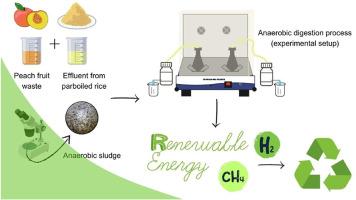Transforming by-products into renewable energy: Biochemical analysis of anaerobic digestion of biowastes for bioreactors optimization supporting the low-carbon agroindustry
IF 8.1
2区 工程技术
Q1 CHEMISTRY, PHYSICAL
引用次数: 0
Abstract
With the expansion in agro-industrial operations there is an urgent need to solve the challenge of dealing with the products waste. Today, an overwhelming portion of this waste ends up in industrial waste disposal sites. Wherefore, anaerobic co-digestion (ACoD) emerges as an effective technique for waste treatment, being environmentally and economically viable, since a microbial community converts by-products into renewable energy in the form of biogas, with high levels of hydrogen and other gases. ACoD has proven effective in the management of organic waste from agro-industry. However, mastering the biochemistry of the process, especially when varying the mixtures of waste used, is essential for controlling biological reactors and optimizing energy production. Even though separate studies have evaluated the anaerobic digestion of rice parboiling effluent and peach processing residue, co-digestion of both are scarcely investigated. The knowledge and mastery of the process parameters using this mixture are essential to ensure effective operational control of anaerobic reactors with maximum energy generation. Therefore, this research evaluated the biogas production from ACoD of rice parboiling effluent and waste of peaches processing. The experiment followed a batch regime based on a 22-factorial arrangement. The factors used were the peach percentage in the substrate (P), which varied from 2.5 to 5%, and the substrate-inoculum ratio (S/I), which was alternated between 1.5 and 2.5 gCOD/gVSS. The average Chemical Oxygen Demand (COD) removal efficiency of the reactors was 82.1% and, after the digestion process, the pH of the reactors remained neutral, showing that anaerobic digestion is a suitable method for treating the assessed wastes. In the analyzed proportions, the higher the peach percentage in the substrate, the lower the total methane production, whereas the S/I demonstrated the opposite effect. Reactors III (S/I = 2.5 and P = 2.5%), presented the most durable and the highest production, being the best combination of the factorial studied. Finally, it can be said that for the state of Rio Grande do Sul, the largest rice and peach producer in Brazil, ACoD of the wastes assessed in this research represents a significantly relevant option, enabling the development of the circular economy, the industrial symbiosis, and the sustainable production in the State.

将副产品转化为可再生能源:生物废料厌氧消化的生化分析,优化生物反应器,支持低碳农业产业
随着农用工业业务的扩大,迫切需要解决处理产品废物的难题。如今,这些废物中的绝大部分都进入了工业废物处理场。因此,厌氧协同消化(ACoD)成为一种有效的废物处理技术,在环境和经济上都是可行的,因为微生物群落可将副产品转化为沼气形式的可再生能源,其中含有大量氢气和其他气体。事实证明,沼气发酵工艺在管理农用工业有机废物方面非常有效。然而,掌握这一过程的生物化学原理,尤其是在改变所使用的废物混合物时,对于控制生物反应器和优化能源生产至关重要。尽管已有研究分别评估了水稻沸腾废水和桃子加工残渣的厌氧消化,但对这两种废水的共消化研究却很少。了解和掌握使用这种混合物的工艺参数对于确保有效控制厌氧反应器的运行并产生最大能量至关重要。因此,本研究评估了水稻沸腾废水和桃子加工废料 ACoD 产生沼气的情况。实验采用了基于 22 个因子排列的间歇式方法。使用的因子是基质中桃子的比例(P),从 2.5%到 5%不等;基质-接种物比(S/I),在 1.5 和 2.5 gCOD/gVSS 之间交替变化。反应器的平均化学需氧量(COD)去除率为 82.1%,消化过程结束后,反应器的 pH 值保持中性,这表明厌氧消化是处理所评估废物的合适方法。在所分析的比例中,基质中桃的比例越高,甲烷总产量就越低,而 S/I 则显示出相反的效果。反应器 III(S/I = 2.5 和 P = 2.5%)最经久耐用,产量最高,是所研究因子的最佳组合。最后,可以说,对于巴西最大的水稻和桃子生产国南里奥格兰德州来说,本研究中评估的废料 ACoD 是一个非常有意义的选择,有助于该州发展循环经济、工业共生和可持续生产。
本文章由计算机程序翻译,如有差异,请以英文原文为准。
求助全文
约1分钟内获得全文
求助全文
来源期刊

International Journal of Hydrogen Energy
工程技术-环境科学
CiteScore
13.50
自引率
25.00%
发文量
3502
审稿时长
60 days
期刊介绍:
The objective of the International Journal of Hydrogen Energy is to facilitate the exchange of new ideas, technological advancements, and research findings in the field of Hydrogen Energy among scientists and engineers worldwide. This journal showcases original research, both analytical and experimental, covering various aspects of Hydrogen Energy. These include production, storage, transmission, utilization, enabling technologies, environmental impact, economic considerations, and global perspectives on hydrogen and its carriers such as NH3, CH4, alcohols, etc.
The utilization aspect encompasses various methods such as thermochemical (combustion), photochemical, electrochemical (fuel cells), and nuclear conversion of hydrogen, hydrogen isotopes, and hydrogen carriers into thermal, mechanical, and electrical energies. The applications of these energies can be found in transportation (including aerospace), industrial, commercial, and residential sectors.
 求助内容:
求助内容: 应助结果提醒方式:
应助结果提醒方式:


